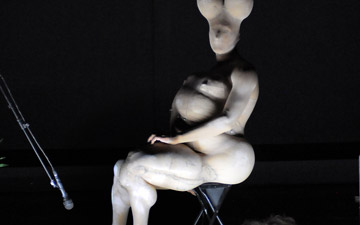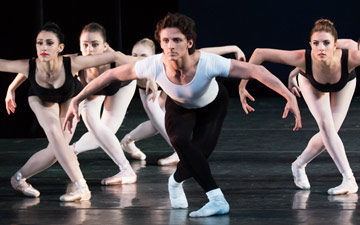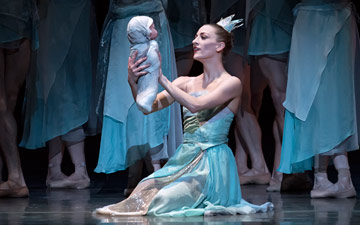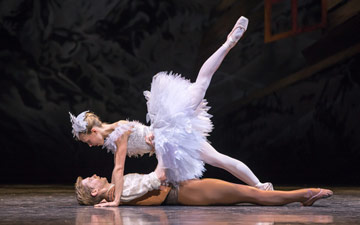
© Marteen Vanden Abeele. (Click image for larger version)
Charleroi Danses
Kiss & Cry
London, Barbican Theatre
25 June 2014
www.charleroi-danses.be
www.barbican.org.uk
I first remember Michèle Anne de Mey as a young dancer with Anne Teresa De Keersmaeker in the 1980s, pacing tirelessly in Fase. Now the mother of four, she’s still dancing and creating. Kiss & Cry is her first collaboration with her husband, Jaco Van Dormael, film maker and theatre director. Together with friends, they sat round the kitchen table and improvised a story using children’s toys and their own hands as characters.
The result is enchantingly low-tech, re-created afresh at every performance. The stage is littered with diminutive props, table-top sets and recording devices. Above hangs a large screen on which the cameraman’s film of the goings-on below is projected, disorienting the spectators’ sense of proportion. Hands are huge, a toy train larger than life; dolls’ house sets veer from tiny to majestic. Yet instead of the action of screen dominating the production, as usually happens, it is the shadowy human beings making the illusions who are the real story.
The narrative thread involves an old woman, Gisèle, recalling past loves. Where do they go to, these significant people who disappear from one’s life but remain unchanged in the memory? In Kiss & Cry, they are represented as toy figurines, stranded in a drawerful of sand. Five come to life, animated as personalities by the fingers of de Mey and Gregory Grosjean. There’s high-flying infatuation (on a miniature circus trapeze), the peace and unease of the marital bed, a passionate pas de deux for entwined palms and limbs, rejection and abandonment. You soon realise it’s not just the hands, magnified on screen, that are dancing but the performers’ bodies, half-hidden in the darkness. Every gesture is invested with emotion, compelling belief in the fantastical tales.
Memory, of course, is unreliable. Gisèle seems to have encountered a dead giraffe in her garden and to have wondered whether an absent lover might have been abducted by aliens. Sand and water swiftly obliterate traces of lost loves; a circling train, a ship and a paper boat suggest life’s journey, which becomes melancholy in old age. Gisèle is lonely and lost, not from Alzheimer’s but haunted by persistent recollections. Unexpectedly, there’s a poignant ending – a resurrection on screen and in the flesh. A wish fulfilment, a confirmation that this was just a fairy tale, after all? Apparently audiences in countries with brutal regimes see it as a political allegory, though the ‘disappeared’ remain unrestored.

















You must be logged in to post a comment.